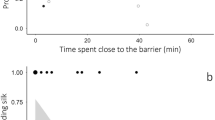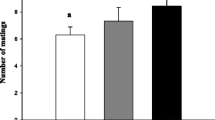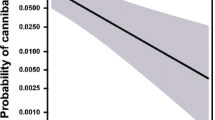Abstract
Sexual signals produced by males are costly. Thus, sexual selection may favour males who are able to minimise these costs, but are still reproductively successful. I investigated male preferences for large and small prey used to produce nuptial gifts, which serve as sexual signals in the nursery web spider, Pisaura mirabilis. Males showed strong preferences for large prey compared to small prey for gift production, which is likely to be more attractive for females and provide males with longer copulation. These preferences were strongest in the presence of female pheromonal cues. Unexpectedly, carrying nuptial gifts did not influence male mobility measured in a 5-min-long behavioural test. Both gifts carried by males and the intact gifts showed similar decreases in mass, suggesting that males did not actively suck the content of the gift. Wrapping the gift with silk did not effectively reduce the gift’s dehydration, meaning that the function of the silk is not to protect the gift’s contents. Males in poor body condition were more likely to feed on the prey before wrapping it. This is consistent with condition dependent signalling, as males in low condition are predicted to feed on the prey as they are not able to pay the cost of gift production. Males preferred large-sized prey for gift production and males in poor body condition reduced the cost of gift production by feeding on the prey, supporting the idea that nuptial feeding is condition dependent.


Similar content being viewed by others
References
Albo M, Toft S, Bilde T (2011a) Condition dependence of male nuptial gift construction in the spider Pisaura mirabilis (Pisauridae). J Ethol 29:473–479
Albo MJ, Winther G, Tuni C, Toft S, Bilde T (2011b) Worthless donations: male deception and female counterplay in a nuptial gift-giving spider. BMC Evol Biol 11:329
Albo MJ, Bilde T, Uhl G (2013) Sperm storage mediated by cryptic female choice for nuptial gifts. Proc. Roy. Soc. B. 280:20131735
Andersen T, Bollerup K, Toft S, Bilde T (2008) Why do males of the spider Pisaura mirabilis wrap their nuptial gifts in silk: female preference or male control? Ethology 114:775–781
Andersson M (1982) Female choice selects for extreme tail length in a widowbird. Nature 299:818–820
Austad SN, Thornhill R (1986) Female reproductive variation in a nuptial feeding spider, Pisaura mirabilis. Bull. Br. Arachnol. Soc. 7:48–52
Bristowe WS (1958) The world of spiders. William Collins, London, U.K.
Bristowe WS, Locket GH (1926) The courtship of British lycosid spiders, and its probable significance. Proc. Zool. Soc. Lond. 2:317–347
Bruun LE, Michaelsen KR, Sørensen A, Nielsen MH, Toft S (2004) Mating duration of Pisaura mirabilis (Araneae: Pisauridae) depends on size of the nuptial gift and not on male size. Arthrop. Sel. 1:35–39
Buchar J, Babrakzai H, Hodek I (1989) Life-cycle and phenology of the spider Pisaura mirabilis (Araneae) in central Europe. Acta Entomol. Bohem. 86:414–418
Emlen DJ, Warren IA, Johns A, Dworkin I, Lavine LC (2012) A mechanism of extreme growth and reliable signaling in sexually selected ornaments and weapons. Science 337:860–864
Engels S, Sauer KP (2006) Resource-dependent nuptial feeding in Panorpa vulgaris: an honest signal for male quality. Behav Ecol 17:628–632
Engqvist L (2007) Sex, food and conflicts: nutrition dependent nuptial feeding and pre-mating struggles in scorpion flies. Behav Ecol Sociobiol 61:703–710
Ghislandi PG, Beyer M, Velado P, Tuni C (2017) Silk wrapping of nuptial gifts aids cheating behaviour in male spiders. Behav Ecol 28:744–749
Ghislandi PG, Pekár S, Matzke M, Schulte-Döinghaus S, Bilde T, Tuni C (2018) Resource availability, mating opportunity and sexual selection intensity influence the expression of male alternative reproductive tactics. J Evol Biol 31:1035–1046
Hromada M, Antczak M, Tryjanowski P (2015) Females prefer extra-pair males that are older and better hunters. Eur. J. Ecol. 1:26–31
Immonen E, Hoikkala A, Kazem AJN, Ritchie MG (2009) When are vomiting males attractive? Sexual selection on condition-dependent nuptial feeding in Drosophila subobscura. Behav Ecol 20:289–295
Johnstone RA, Grafen A (1993) Dishonesty and the handicap principle. Anim Behav 46:759–764
Kodric-Brown A, Brown JHJ (1984) Truth in advertising: the kinds of traits favored by sexual selection. Am Nat 124:309–323
Kotiaho JS (2001) Costs of sexual traits: a mismatch between theoretical considerations and empirical evidence. Biol Rev 76:365–376
Kotiaho J, Alatalo RV, Mappes J, Nielsen MG, Parri S, Rivero A (1998) Energetic costs of size and sexual signaling in a wolf spider. Proc R Soc Lond B 265:2203–2209
Kotiaho JS, Alatalo RV, Mappes J, Parri S (1999) Sexual signalling and viability in a wolf spider (Hygrolycosa rubrofasciata): Measurements under laboratory and field conditions. Behav Ecol Sociobiol 46:123–128
Lang A (1996) Silk investment in gifts by males of the nuptial feeding spider Pisaura mirabilis (Araneae: Pisauridae). Behaviour 133:697–716
Macedo-Rego RC, Costa-Schmidt LE, Santos ES, Machado G (2016) Negative effects of prolonged dietary restriction on male mating effort: nuptial gifts as honest indicators of long-term male condition. Sci. Rep. 6:21846
Maxwell MR, Prokop P (2018) Fitness effects of nuptial gifts in the spider Pisaura mirabilis: examination under an alternative feeding regime. J. Arachnol. 46:404–412
Mobley KB, Morrongiello JR, Warr M, Bray D, Wong BB (2018) Female ornamentation and the fecundity trade-off in a sex-role reversed pipefish. Ecol. Evol. 8:9516–9525
Møller AP (1990) Fluctuating asymmetry in male sexual ornaments may reliably reveal male quality. Anim Behav 40:1185–1187
Nitzche ROM (1988) Brautgeschenk’ und Umspinnen der Beute be Pisaura mirabilis, Dolomedes fimbriatus und Thaumasia uncata (Arachnida, Araneida, Pisauridae). Verh. Natur. Ver. Hamb. 30:353–393
Prokop P (2006) Insemination does not affect female mate choice in a nuptial feeding spider. Ital. J. Zool. 73:197–201
Prokop P, Maxwell MR (2009) Female feeding regime and polyandry in the nuptially feeding nursery-web spider, Pisaura mirabilis. Naturwissenschaften 96:259–265
Prokop P, Maxwell MR (2012) Gift -carrying in the spider Pisaura mirabilis: nuptial gift contents in nature and effects on male running speed and fighting success. Anim Behav 83:1395–1399
Prokop P, Semelbauer M (2017) Biometrical and behavioural associations with offering nuptial gifts by males in the spider Pisaura mirabilis. Anim Behav 129:189–196
Roulin A (2016) Condition-dependence, pleiotropy and the handicap principle of sexual selection in melanin-based colouration. Biol Rev 91:328–348
Simmons LW, Parker GA (1989) Nuptial feeding in insects: mating effort versus paternal investment. Ethology 81:332–343
Stålhandske P (2001) Nuptial gift in the spider Pisaura mirabilis maintained by sexual selection. Behav Ecol 12:691–697
Számadó S (2011) The cost of honesty and the fallacy of the handicap principle. Anim Behav 81:3–10
Thornhill R, Alcock J (1983) The evolution of insect mating systems. Harvard University Press, Cambridge, MA
Tryjanowski P, Hromada M (2005) Do males of the great grey shrike, Lanius excubitor, trade food for extrapair copulations? Anim Behav 69:529–533
Tuni C, Albo MJ, Bilde T (2013) Polyandrous females acquire indirect benefits in a nuptial-feeding species. J Evol Biol 26:1307–1316
Vahed K (1998) The function of nuptial feeding in insects: a review of empirical studies. Biol Rev 73:43–78
Vahed K (2007) All that glisters is not gold: Sensory bias, sexual conflict and nuptial feeding in insects and spiders. Ethology 113:105–127
Van Hasselt AWM (1884) Waarnemingen omtrent anomaliën van de geslachtsdrift bij spinnen-mares. Tijd. Ent. 27:197–206
Verhulst S, Dieleman SJ, Parmentier HK (1999) A trade-off between immunocompetence and sexual ornamentation in domestic fowl. Proc Natl Acad Sci 96:4478–4481
Weaver RJ, Koch RE, Hill GE (2017) What maintains signal honesty in animal colour displays used in mate choice? Phil. Trans. R. Soc. B 372:20160343
West PM (2002) Sexual selection, temperature, and the lion’s mane. Science 297:1339–1343
Zahavi A (1975) Mate selection—a selection for handicap. J Theor Biol 53:205–214
Zahavi A (1977) Cost of honesty (further remarks on handicap principle). J Theor Biol 67:603–605
Acknowledgments
Two anonymous referees provided extremely helpful and insightful comments on an earlier draft of this manuscript. David Livingstone improved the English. Jana Fančovičová helped me with collection of spiders. This work was supported by the Slovak Grant Agency VEGA (no. 1/0104/16).
Compliance with ethical standards
Conflict of interest. The author has no conflict of interest to declare.
Ethical approval
All applicable international, national, and institutional guidelines for the care and use of animals were followed. This article does not refer to any studies with human participants performed by the author.
Author information
Authors and Affiliations
Corresponding author
Additional information
Publisher's Note
Springer Nature remains neutral with regard to jurisdictional claims in published maps and institutional affiliations.
About this article
Cite this article
Prokop, P. Male preferences for nuptial gifts and gift weight loss amongst the nursery web spider, Pisaura mirabilis. J Ethol 37, 363–370 (2019). https://doi.org/10.1007/s10164-019-00612-7
Received:
Accepted:
Published:
Issue Date:
DOI: https://doi.org/10.1007/s10164-019-00612-7




